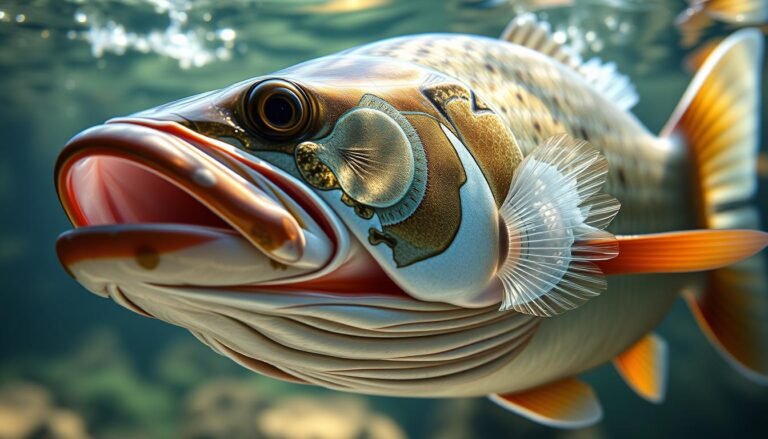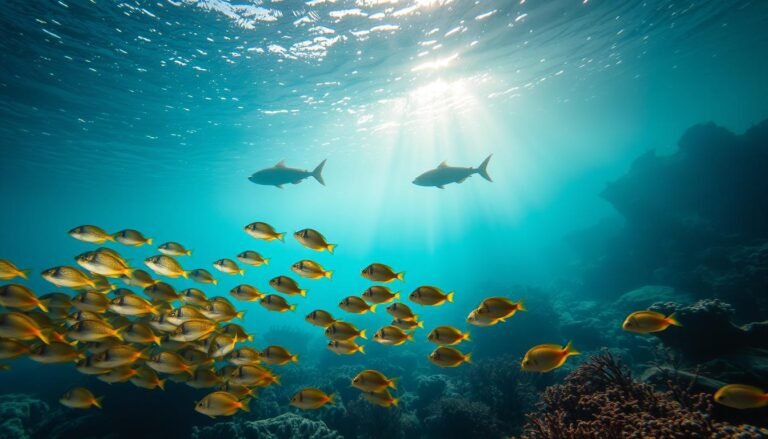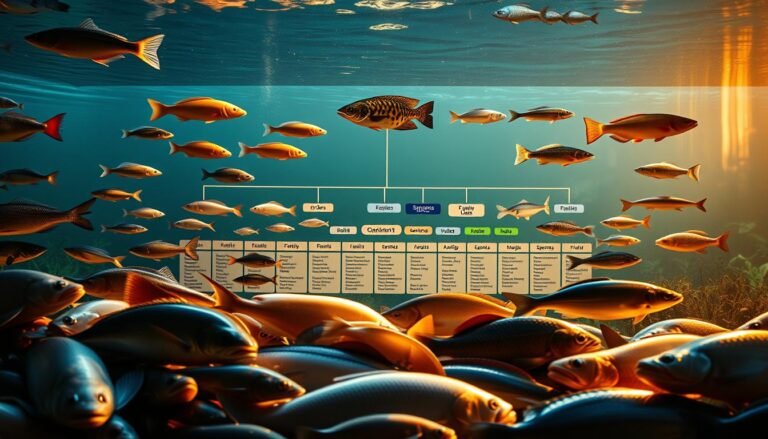Snapper fish are a fascinating species, and understanding their dietary habits is crucial for both anglers and marine biology enthusiasts. Their diverse diet consists of various crustaceans, small fish, and mollusks, making them a vital part of the marine ecosystem.
The feeding habits of snapper fish are influenced by their environment and the availability of food sources. In the wild, they play a significant role in maintaining the balance of their ecosystems.
Key Takeaways
- Snapper fish have a diverse diet that includes crustaceans, small fish, and mollusks.
- Their feeding habits are influenced by their environment and food availability.
- Understanding snapper diet is crucial for anglers and marine biology enthusiasts.
- Snapper fish play a vital role in maintaining the balance of their ecosystems.
- Their dietary habits can vary depending on the species and location.
Snapper Fish: An Overview of These Australian Favourites
Snapper are one of the most sought-after fish species in Australia, inhabiting various marine environments. They are a popular game fish among anglers, known for their challenging behaviour and excellent flavour.
Common Snapper Species in Australian Waters
Australia is home to several species of snapper, with the Southern Snapper and Yellowfin Snapper being among the most common. These species are found in coastal waters, often near reefs and estuaries, where they feed on a variety of prey including crustaceans and small fish. For more information on how to catch Southern Snapper, you can visit Tackle Tactics.
Habitat and Distribution Around Australia
Snapper are distributed across various Australian waters, from the temperate regions of the south to the tropical waters of the north. They are commonly found in areas with rocky reefs, estuaries, and coastal waters, where they can feed on their preferred diet. The table below summarizes their distribution and common habitats.
| Region | Common Habitats |
|---|---|
| Southern Australia | Rocky reefs, coastal waters |
| Northern Australia | Tropical reefs, estuaries |
| Eastern Australia | Estuaries, coastal waters |
What Do Snapper Eat? Their Natural Diet Explained
Snapper are opportunistic feeders, consuming a wide range of prey that is available in their habitat. Their diet is influenced by various factors including the season, their environment, and the availability of food sources.

Primary Food Sources for Snapper
The primary food sources for snapper include crustaceans, small fish, and mollusks. Crustaceans such as crabs and prawns are a significant component of their diet, providing essential nutrients.
| Food Source | Nutritional Value | Seasonal Availability |
|---|---|---|
| Crustaceans | High in protein | Available year-round |
| Small Fish | Rich in omega-3 fatty acids | More abundant during summer |
| Mollusks | Good source of minerals | Available throughout the year |
Seasonal Variations in Snapper Diet
The diet of snapper varies seasonally, with changes in water temperature and prey availability. During warmer months, snapper tend to consume more small fish and crustaceans.
Seasonal dietary changes: In colder months, their diet may shift towards more readily available mollusks and other bottom-dwelling organisms.
Opportunistic Feeding Behaviours
Snapper exhibit opportunistic feeding behaviours, adapting their diet based on what is available in their environment. This adaptability is key to their survival in varying aquatic conditions.
Feeding flexibility: Their ability to switch between different food sources allows them to thrive in diverse ecosystems.
Crustaceans: A Snapper’s Favourite Meal
In Australian seas, snapper are known to feed extensively on crustaceans, a key component of their diet. This preference for crustaceans is a significant aspect of snapper feeding facts, highlighting their opportunistic feeding behaviour.
Types of Crabs and Prawns in Snapper Diet
Snapper feed on a variety of crabs and prawns. The types of crustaceans consumed can vary based on availability and the snapper’s habitat.
- Mud crabs
- Blue swimmer crabs
- School prawns
- King prawns
How Snapper Hunt and Consume Crustaceans
Snapper use various strategies to hunt crustaceans, including ambush and active foraging. Their ability to consume a range of crustacean sizes and types makes them efficient predators in Australian waters.
Australian Crustacean Species Commonly Eaten
The specific crustacean species consumed by snapper can vary by region. However, certain species are commonly targeted across different areas.
| Crustacean Species | Region |
|---|---|
| Mud Crabs | Estuaries and Mangroves |
| Blue Swimmer Crabs | Coastal Waters |
| School Prawns | Estuaries and Coastal Waters |
Understanding the diet of snapper, including their preference for crustaceans, is essential for both anglers and conservationists. It provides insights into saltwater fish food preferences and can inform sustainable fishing practices.
Small Fish and Baitfish in the Snapper Diet
Snapper are opportunistic feeders, with small fish and baitfish being a major part of their natural diet. These fish are abundant in Australian waters and provide a rich source of nutrients for snapper.

Common Baitfish Species Targeted by Snapper
Snapper prey on various baitfish species, including sardines, anchovies, and hardyheads. These small fish are often found in schools, making them an easily accessible food source.
| Baitfish Species | Characteristics | Seasonal Availability |
|---|---|---|
| Sardines | Small, oily fish that school in large numbers | More abundant during warmer months |
| Anchovies | Small, schooling fish with a high oil content | Available year-round, with peaks in certain regions |
| Hardyheads | Small fish with a distinctive silver stripe | Common in estuarine and coastal waters |
Hunting Techniques for Catching Smaller Fish
Snapper employ various hunting techniques to catch small fish and baitfish. They are known to ambush prey, using their speed and agility to catch unsuspecting fish.
Ambush predation is a common technique used by snapper, where they lie in wait in hiding spots such as under rocks or near reefs, then quickly strike at passing schools of baitfish.
Seasonal Availability of Baitfish in Australian Waters
The availability of baitfish in Australian waters varies seasonally, influenced by factors such as water temperature and the presence of certain marine habitats. Understanding these patterns can provide insights into snapper feeding habits.
For example, during the warmer months, sardines and other baitfish are more abundant, providing a rich food source for snapper. This seasonal variation is crucial for anglers and researchers alike to understand the dynamics of snapper diet and feeding patterns.
Molluscs and Other Shellfish as Snapper Food
Molluscs form a significant part of the snapper’s diet, showcasing their adaptability as predators. Snapper fish are opportunistic feeders, and their diet reflects the availability of food sources in their environment.
Types of Molluscs Consumed
Snapper consume a variety of molluscs, including clams, mussels, and squid. These molluscs are rich in nutrients, making them a valuable food source.
How Snapper Break Through Shells
Snapper have developed strong jaws and teeth that enable them to break through the shells of molluscs. This adaptation allows them to access the nutritious flesh inside, making molluscs a reliable food source.
Australian Shellfish Species in Snapper Diet
In Australian waters, snapper feed on various shellfish species, including the commercially valuable scallops and oysters. The availability of these species can vary by region, influencing the local snapper diet.
Feeding Habits and Behaviours of Snapper
The feeding habits of snapper are complex and influenced by various factors, including time of day and environmental conditions. Snapper are known to be opportunistic feeders, adjusting their diet based on what’s available in their environment.
Daily Feeding Patterns
Snapper exhibit specific daily feeding patterns. They are typically more active during certain times of the day, such as dawn and dusk, when they hunt for food. Understanding these patterns can help anglers increase their chances of catching snapper. Research has shown that snapper tend to feed more actively during these twilight hours, making them more likely to take bait.
Hunting Strategies and Techniques
Snapper employ various hunting strategies to catch their prey. They are known to use ambush tactics, lying in wait for unsuspecting fish and crustaceans. Their ability to adapt their hunting techniques to different environments is a key factor in their success as predators. Snapper have also been observed actively chasing down prey, especially in areas with abundant food sources.
“Snapper are opportunistic feeders, taking advantage of whatever food sources are available to them.”
Environmental Factors Affecting Feeding
Environmental factors play a significant role in influencing the feeding behaviours of snapper. Water temperature, tidal cycles, and the presence of certain prey can all impact when and how snapper feed. For example, changes in water temperature can affect the availability of certain prey species, in turn affecting snapper feeding patterns. Anglers who understand these environmental influences can better predict when snapper are likely to be feeding.
By understanding the feeding habits and behaviours of snapper, including their daily feeding patterns, hunting strategies, and the environmental factors that influence them, anglers can develop more effective fishing strategies. This knowledge not only enhances the fishing experience but also contributes to more sustainable fishing practices.
Diet Variations by Snapper Age and Size
Snapper feeding habits are not static; they evolve as the fish age and grow in size. This variation in diet is a crucial aspect of understanding the overall feeding behaviour of snapper in Australian waters.
Juvenile Snapper Feeding Habits
Juvenile snapper tend to feed on smaller prey, including tiny crustaceans and plankton. Their diet is often limited by their size and the developmental stage of their feeding apparatus. As they grow, they begin to incorporate larger food items into their diet.
Adult Snapper Dietary Preferences
Adult snapper have a more varied diet that includes larger crustaceans, molluscs, and small fish. Their feeding habits are influenced by their environment and the availability of food sources. Adults are opportunistic feeders, taking advantage of whatever is abundant in their habitat.
How Diet Changes Throughout a Snapper’s Life Cycle
As snapper mature, their diet changes significantly. The transition from juvenile to adult feeding habits is marked by an increase in the size and variety of prey consumed. This change is driven by the need for more substantial nutrition to support growth and reproduction. Understanding these dietary shifts is essential for gaining insights into snapper feeding facts and their role in the marine ecosystem as a saltwater fish food source.
By examining the dietary variations across different life stages, we can better understand the complex feeding behaviours of snapper and their importance in Australian marine ecosystems.
Regional Differences in Snapper Diet Across Australian Waters
Regional variations in snapper diet are influenced by the availability of food sources in different marine ecosystems across Australian waters. This diversity in diet is a reflection of the adaptability of snapper to their local environments.
East Coast vs. West Coast Dietary Variations
The diet of snapper on the east coast of Australia tends to include more tropical species, reflecting the warmer waters and diverse marine life. In contrast, snapper on the west coast consume a diet that is more influenced by the cooler, nutrient-rich waters of the Indian Ocean.
Northern vs. Southern Water Feeding Patterns
In northern Australian waters, snapper feed on a variety of species that thrive in the tropical conditions, including various crustaceans and small fish. In southern waters, the diet shifts to include more temperate species, with a greater emphasis on molluscs and other shellfish.
Unique Food Sources in Different Australian Marine Ecosystems
Different marine ecosystems across Australia provide unique food sources for snapper. For example, in coral reef ecosystems, snapper feed on a diverse array of fish and invertebrates. In estuarine environments, they consume more prawns and small crustaceans.
| Region | Primary Food Sources |
|---|---|
| East Coast | Tropical fish, crustaceans |
| West Coast | Temperate fish, molluscs |
| Northern Waters | Crustaceans, small tropical fish |
| Southern Waters | Molluscs, shellfish |
Understanding these regional differences in snapper diet is crucial for both fishing practices and conservation efforts. By recognizing the diverse feeding habits of snapper across Australian waters, we can better manage their populations and the ecosystems they inhabit.
How Snapper Feeding Habits Influence Fishing Techniques
The natural diet and feeding behaviors of snapper are essential considerations for anglers. Understanding these aspects can significantly enhance fishing strategies, from choosing the right bait to determining the best times and locations for fishing.
As snapper are opportunistic feeders with a varied diet, replicating their natural food sources can be an effective fishing strategy. This includes using baits such as crustaceans, small fish, and molluscs, which are staples in a snapper’s diet.
Best Baits Based on Natural Diet
Using baits that mimic the natural diet of snapper can increase the chances of a successful catch. Crustaceans like crabs and prawns, as well as small fish and squid, are among the preferred baits. According to a study, “the use of natural baits can improve catch rates by up to 30% compared to artificial lures.”
“Fishing with natural baits that reflect the local snapper diet can significantly enhance catch success.”
Fishing Times and Locations Based on Feeding Patterns
Snapper feeding patterns vary with the time of day, tidal cycles, and seasonal changes. Fishing during peak feeding times, such as dawn and dusk, and in locations known for abundant food sources, can improve fishing success. For instance, areas with rocky reefs or near estuaries are often rich in the crustaceans and small fish that snapper prey on.
Sustainable Fishing Practices That Consider Snapper Diet
Adopting sustainable fishing practices that consider the diet and feeding habits of snapper is crucial for maintaining healthy fish populations. This includes avoiding overfishing, respecting catch limits, and using fishing gear that minimizes bycatch. By doing so, anglers can help ensure the long-term sustainability of snapper fisheries.
Conclusion: Understanding Snapper Diet for Better Fishing and Conservation
Understanding what snapper eat and their feeding habits is crucial for both effective fishing practices and conservation efforts. Snapper diet varies significantly based on factors like age, size, and regional location, making it essential to grasp these nuances for sustainable management.
Snapper feeding facts reveal that these saltwater fish are opportunistic feeders, consuming a wide range of prey from crustaceans to small fish and molluscs. This varied diet is influenced by seasonal changes, daily feeding patterns, and environmental factors, highlighting the complexity of their feeding behaviours.
By understanding snapper diet and saltwater fish food sources, anglers can adopt more effective fishing techniques, while conservationists can develop targeted strategies to protect these iconic Australian species. As we continue to learn more about snapper biology, we can work towards better conservation outcomes and sustainable fishing practices that preserve snapper populations for future generations.



